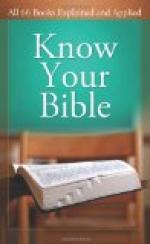* * * * *
Chapter XI.
Ezra, Nehemiah and Ester.
Ezra and Nehemiah.
Name. Ezra and Nehemiah were formerly counted as one book and contain the account of the restoration of the exiles to Jerusalem and the re-establishment of their worship. They soon came to be called First and Second Ezra. Jerome first called the second book Nehemiah. Wycliffe called them the first and second Esdras and later they were called the books of Esdras otherwise the Nehemiahs. The present names were first given in the Geneva Bible (1560). Ezra is so called from the author and principal character, the name meaning “help”. Nehemiah is so called from the principal character, whose name means “Jehovah comforts.”
Other Books. Three other books should be read in connection with this study. (1) The book of Esther, which relates to this time and should be read between chapters 6 and 7 of the book of Ezra. (2) The books of Haggai and Zechariah. These two prophets were associated with the first return of Zerubbabel and their words incited the Jews to complete the temple in spite of opposition.
The Return from Captivity. The return consisted of three expeditions led respectively by Zerubbabel. Ezra and Nehemiah. The time covered can not be accurately calculated. It is probably not fewer than ninety years. Some think it may have been as many as one hundred and ten years.
Analysis of Ezra.
I. The Rebuilding of the Temple, Chs. 1-6.
1. The proclamation of Cyrus, 1.
2. Those who returned, 2.
3. The foundation laid, 3.
4. The work hindered, 4.
5. The work finished, 5-6.
II. The Reforms of Ezra, Chs. 7-10.
1. Ezra’s Journey, 7-8
2. The confession of sin, 9.
3. The covenant to keep the law. 10.
For Study and Discussion. (1) The traits of character displayed by Ezra. (2) The reforms of Ezra. (a) What were they? (b) Parallel conditions of today. (3) The adversaries of Judah. (a) Who were they? (b) The nature of their opposition. (4) The decree of Cyrus. (5) The expedition of Zerubbabel and Ezra. (6) Ezra’s commission and the king’s orders 7:1-26. (7) God’s use of friends and enemies in forwarding his purposes.
Analysis of Nehemiah.
I. The Rebuilding of the Wall, Chs. 1-7.
1. Nehemiah permitted to go to Jerusalem, 1-2.
2. The work on the walls and its hindrance, 3-7.
II. The Covenant to Keep the Law, Chs. 8-10.
1. The law read, 8.
2. Confession made, 9.
3. The covenant made, 10.
III. The Walls Dedicated and Nehemiah’s Reform, Chs. 11-13.
1. Those who dwelt in the city, 11:1-12:26.
2. The walls dedicated, 12:27-47 end.
3. Evils corrected, Ch. 13.




